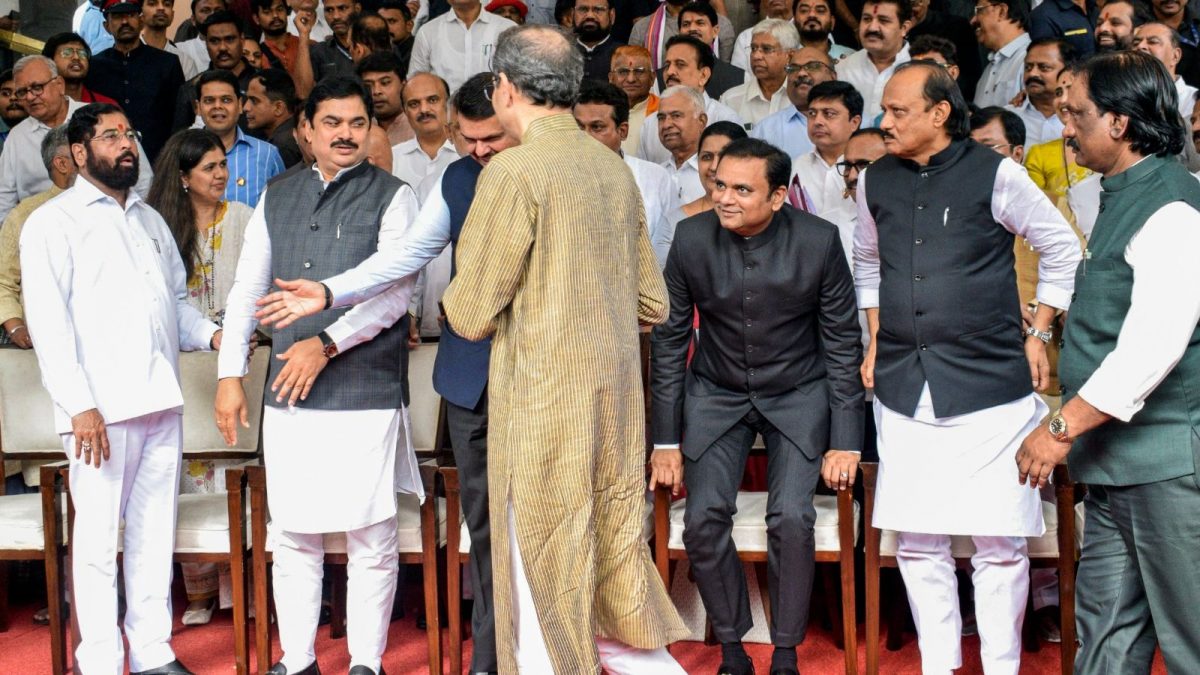 |
|
The political landscape of Maharashtra, already known for its dramatic twists and turns, witnessed another such moment recently when former allies turned political rivals, Uddhav Thackeray and Eknath Shinde, found themselves face-to-face during a photo session at the state assembly. The occasion was a farewell event for Legislative Council opposition Leader Ambadas Danve, bringing together a diverse group of leaders on the assembly steps for what would typically be a routine group photograph. However, the presence of both Thackeray and Shinde, whose relationship has been strained since Shinde's split from the Shiv Sena and subsequent formation of a new government, transformed the event into a scene fraught with tension and unspoken animosity. The article vividly portrays the awkwardness and deliberate avoidance between the two leaders, highlighting the deep political fissures that have reshaped Maharashtra's political dynamics. The entire episode serves as a stark reminder that political relationships, once forged in camaraderie and shared ideology, can quickly unravel, leaving behind a trail of bitterness and rivalry. The event, ostensibly a simple photo opportunity, became a stage for the unfolding drama of Maharashtra's political narrative.
The sequence of events leading up to the photograph is meticulously described, emphasizing the anticipation and underlying tension as various political figures arrived and took their positions. Ajit Pawar's arrival, followed by Council chairman Ram Shinde and deputy chairperson Neelam Gorhe, set the stage. The arrival of Chief Minister Devendra Fadnavis, a key figure in the current ruling coalition, further heightened the sense of anticipation. However, the real drama began with the arrival of Eknath Shinde, who, according to the article, almost jogged to claim his spot, suggesting a sense of urgency or perhaps a desire to assert his position. The atmosphere became even more charged with the unexpected appearance of Uddhav Thackeray. The subtle gestures and hesitant movements of the leaders revealed the delicate balance of power and the discomfort stemming from their fractured relationship. The article masterfully captures the unspoken communication and body language that conveyed more than words could express. The tension reached its peak as Thackeray paused, contemplating whether to sit next to Shinde, the man who had effectively dismantled his political empire.
Neelam Gorhe's intervention, offering Thackeray her seat next to Shinde, further intensified the already palpable tension. Gorhe, who had previously been a staunch supporter of Thackeray, now found herself aligned with the Shinde camp, symbolizing the shifting loyalties and political realignments that have characterized Maharashtra's recent political history. The crowd watched with bated breath, aware of the significance of Thackeray's decision. Would he accept the seat and attempt to project an image of normalcy, or would he refuse, thereby publicly acknowledging the irreparable rift between them? Thackeray's eventual decision to sit, with Gorhe acting as a 'human buffer,' provided a temporary resolution but did little to alleviate the underlying tension. The description of Shinde's fidgeting with his glasses and Thackeray's deliberate avoidance of eye contact paints a picture of strained civility masking deep-seated animosity. The entire scene underscored the complex dynamics of political relationships, where personal feelings often intertwine with strategic considerations and power struggles.
The photograph itself, described as a collection of 'smiles that hid cold shoulders,' serves as a powerful metaphor for the state of Maharashtra's politics. It is a visual representation of the facade of unity and cooperation that often masks the underlying divisions and rivalries that define the political landscape. The article highlights the deliberate efforts of both Shinde and Thackeray to avoid acknowledging each other's presence, further emphasizing the depth of their estrangement. Shinde's preoccupation with adjusting his chair and turning away, coupled with Thackeray's focus on conversing with Gorhe, underscores the conscious effort to maintain a distance, both physically and emotionally. The photograph, intended to capture a moment of unity and camaraderie, instead became a testament to the fractured relationships and political maneuvering that have come to define Maharashtra's political scene. It is a snapshot of a political era marked by betrayal, ambition, and the relentless pursuit of power.
The swift departure of Shinde and Thackeray immediately after the photo session further reinforces the sense of awkwardness and discomfort that permeated the event. Shinde's decision to leave 'without looking back' suggests a desire to distance himself from the situation as quickly as possible, perhaps to avoid any further interaction with Thackeray. Thackeray's polite handshake with Fadnavis before exiting, while seemingly innocuous, could be interpreted as a subtle gesture of defiance or a veiled attempt to maintain some semblance of political equilibrium. The entire episode, from the initial anticipation to the hurried departures, highlights the fragility of political alliances and the enduring impact of personal relationships on the broader political landscape. The event, while seemingly insignificant on the surface, offers a revealing glimpse into the complex dynamics of power, ambition, and personal animosity that shape the course of Maharashtra's political trajectory.
In conclusion, the article effectively captures the tension and awkwardness surrounding the reunion of Uddhav Thackeray and Eknath Shinde at the state assembly photo session. The detailed descriptions of the events leading up to the photograph, the subtle gestures and body language of the leaders, and the overall atmosphere of strained civility provide a compelling narrative of the fractured political landscape of Maharashtra. The event, while seemingly a minor episode, serves as a microcosm of the broader political dynamics at play, highlighting the complex interplay of personal relationships, political ambition, and the ever-shifting sands of power. The photograph, with its 'smiles that hid cold shoulders,' stands as a lasting symbol of the political divisions that have reshaped Maharashtra's political identity and underscores the enduring impact of personal rivalries on the course of political history. The author, Mayuresh Ganapatye, effectively uses descriptive language and insightful observations to bring this moment to life, allowing readers to understand the depth of the chasm that now exists between these two former allies.
Source: Say Cheese...Or Not: When Uddhav Thackeray, Eknath Shinde 'Reunited' For An Awkward Photo-Op
